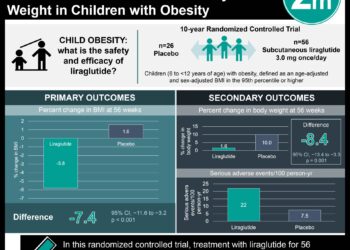Cleft palate surgery at six months has superior outcomes to surgery at one year
1. In this randomized controlled trial, isolated cleft palate surgery at six months resulted in a reduced risk of developing velopharyngeal insufficiency at five years as compared to surgery at 12 months.
2. There was no difference in speech, dentofacial, or growth development between surgery completed at six months versus 12 months.
Evidence Rating Level: 1 (Excellent)
Study Rundown: Isolated cleft palate is a common condition worldwide, whereby the optimal timing, technique, and number of surgeries for optimal development are debated. A key goal in surgical repair of cleft palate is prevention of velopharyngeal insufficiency. That is, the promotion of closure between the velum and pharyngeal walls, so that an intact anatomy may be established early. Currently, there is no consensus for the timing of surgery in isolated cleft palate. This was a multi-center randomized controlled trial comparing the outcomes of isolated cleft palate surgery when completed at six months versus 12 months on velopharyngeal insufficiency. Results of the study found that there was a significantly lower risk of velopharyngeal insufficiency when surgery is completed at six months, rather than 12 months. Apart from increased canonical babbling from the six-month group, there were no differences in speech development, dentofacial development, or growth development. However, there are some confounding effects, such as unintended deviations from interventions between surgeons and across different centers, which may bias results. Overall, this study provided good evidence that surgical repair of isolated cleft palates may be more beneficial at six months than 12 months at promoting velopharyngeal function.
Click to read the study in NEJM
In-Depth [randomized controlled trial]: This was an international randomized controlled trial evaluating outcomes of cleft palate surgery at different ages of infants across Europe and South America. The primary analysis focused on determining the presence of velopharyngeal insufficiency at five years old based on their velopharyngeal composite summary score (VPC-Sum). Additional outcomes of interest included developmental metrics such as speech, dentofacial, growth, as well as hearing sensitivity and the presence of any postoperative complications. Infants who presented to referring centers with isolated cleft palates who were deemed medically able to receive cleft palate surgery at six months old were included. Infants with developmental delay, syndromic cleft palate, certain structural abnormalities, and those without at least one caregiver able to speak the native language were excluded. After applying the inclusion and exclusion criteria, 558 infants across 23 centers were randomized in a 1:1 ratio to receive cleft palate surgery at either six months, or 12 months old. Primary results of the analysis found that infants in the six-month group demonstrated a significantly lower risk of developing velopharyngeal insufficiency at five years compared to the 12-month group (risk ratio, 0.59; 95% confidence interval, 0.36-0.99; p=0.04). Results of secondary outcomes found that infants in the six-month group demonstrated a higher proportion of canonical babbling compared to the 12-month group. There were no differences in any of the other secondary outcomes of interest between the two groups. In summary, this was a well-designed study that provided valuable evidence that surgical repair of isolated cleft palates at six months may be superior to surgery at 12 months in reducing the incidence of velopharyngeal insufficiency.
Image: PD
©2023 2 Minute Medicine, Inc. All rights reserved. No works may be reproduced without expressed written consent from 2 Minute Medicine, Inc. Inquire about licensing here. No article should be construed as medical advice and is not intended as such by the authors or by 2 Minute Medicine, Inc.







